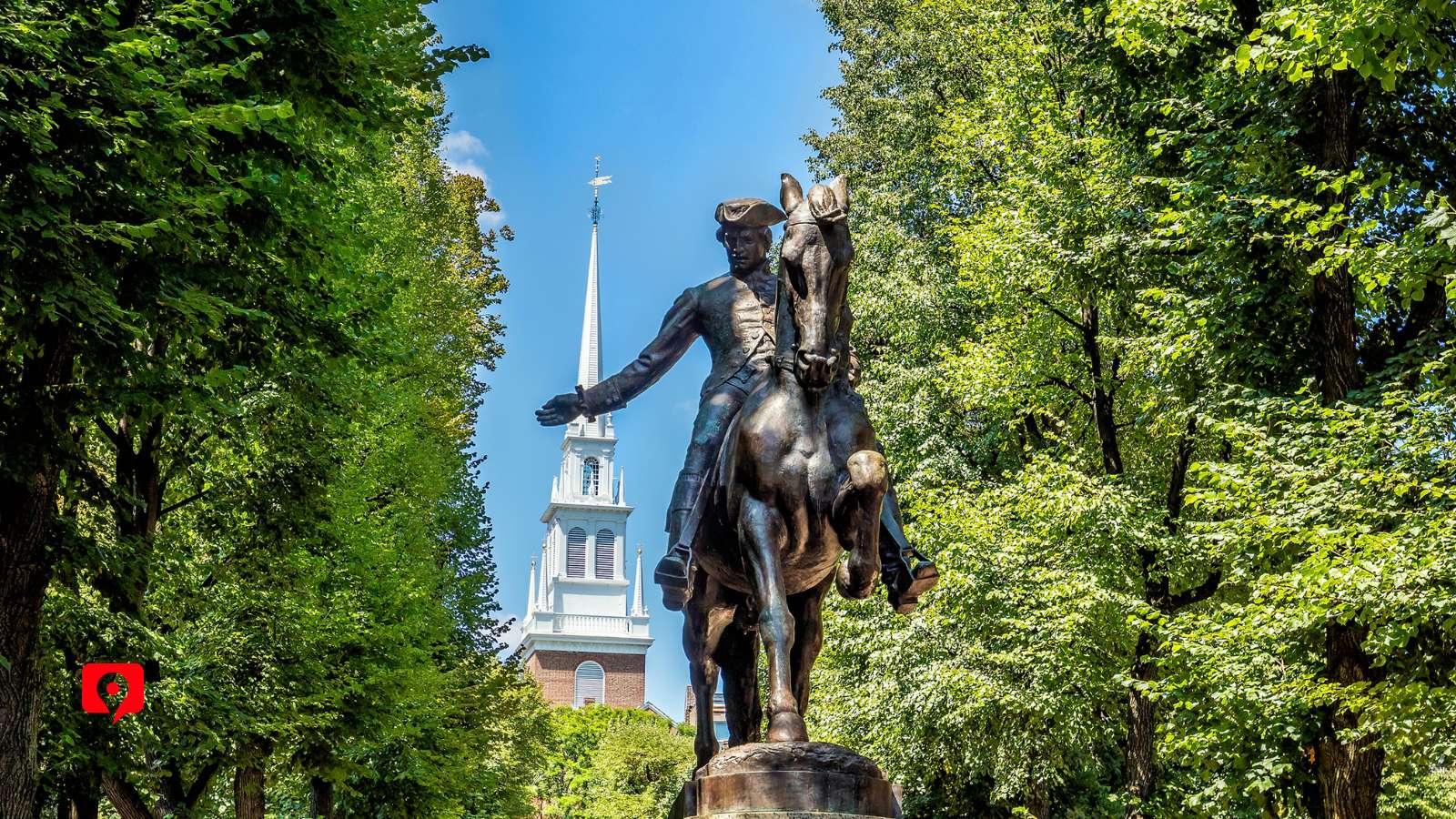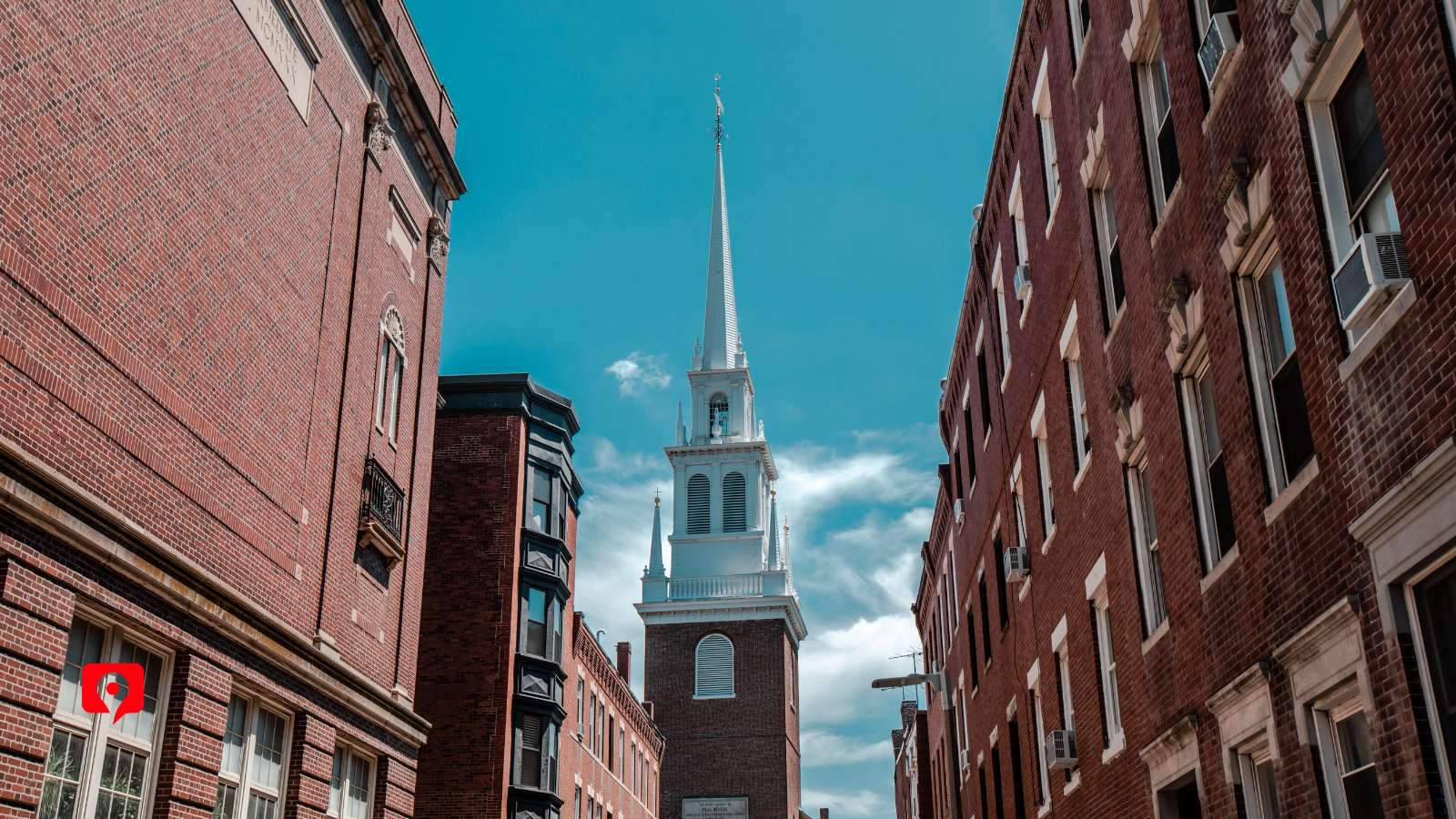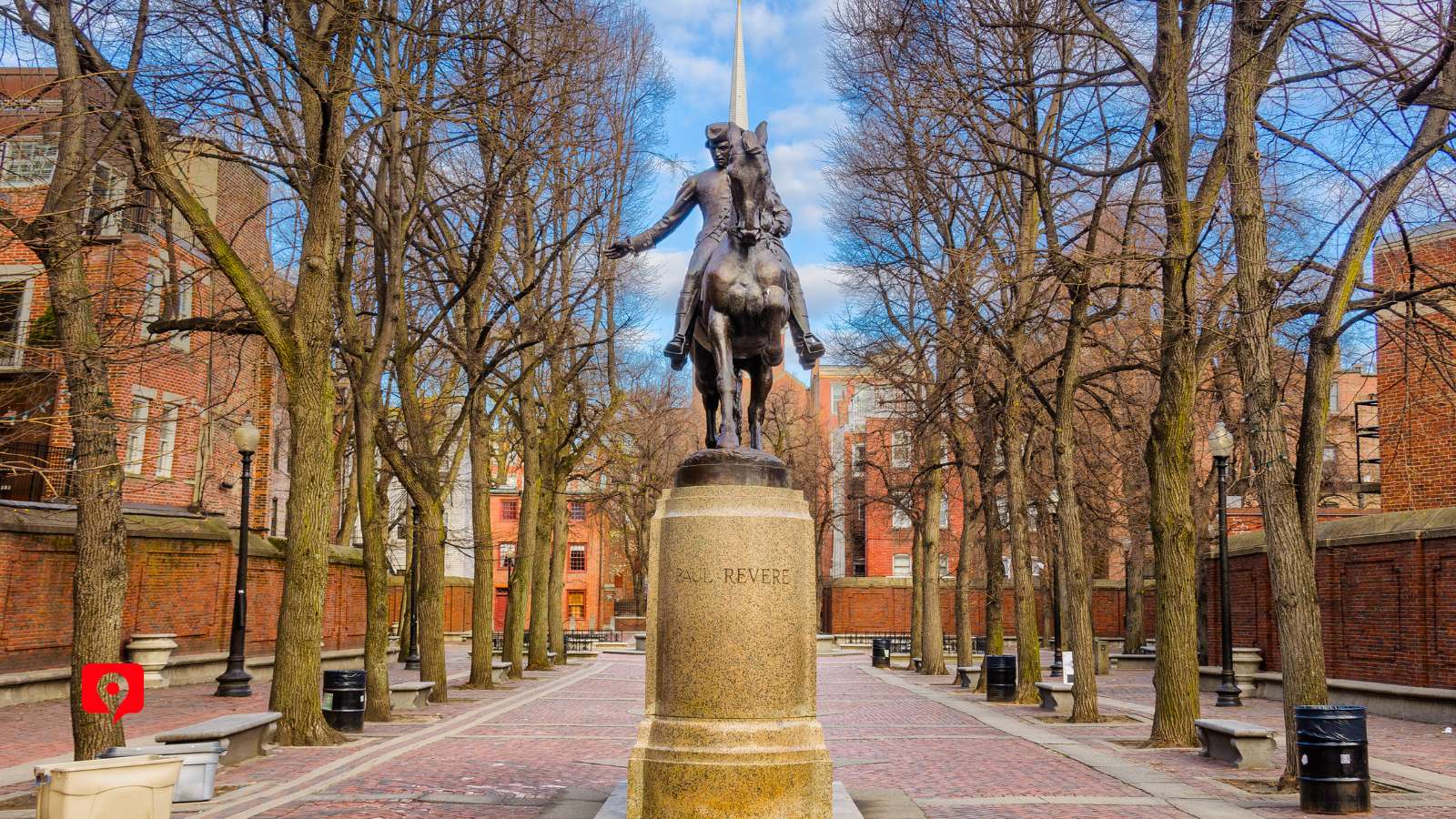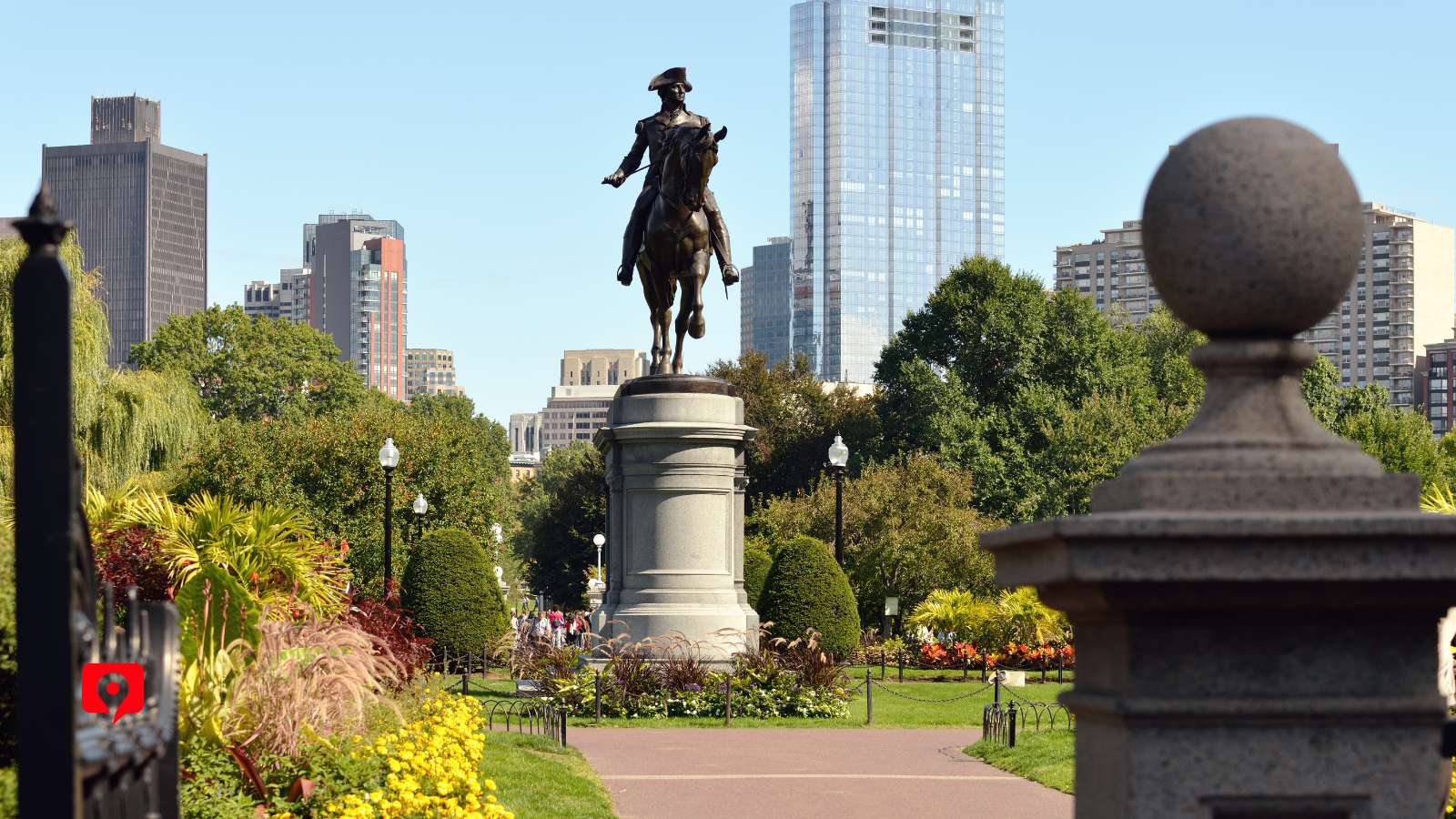00:00

The Freedom Trail immerses visitors in the powerful legacy of the American Revolution. This well-marked, 2.5-mile path winds through Boston’s historic core, connecting 16 pivotal landmarks that shaped the nation’s founding. It’s perfect for anyone eager to explore history without straying far from city comforts.
Begin your journey at Boston Common or the Bunker Hill Monument, then follow the red-brick trail past sites like Faneuil Hall, the Old State House, and the Old North Church, where lanterns once signaled the start of Paul Revere’s midnight ride. Each stop reveals stories of courage, protest, and resilience.
Along the way, interpretive plaques bring the past to life, offering insight into key moments like the Boston Massacre and the birth of the U.S. Navy. With walkable streets and rich storytelling, the Freedom Trail offers a memorable experience for history lovers and casual explorers alike.
Exploring Boston’s Freedom Trail is simple, whether you’re arriving by subway, car, or walking from nearby neighborhoods. The route winds through the heart of the city, passing landmarks and public spaces that are easily accessible for visitors. Getting set up for your tour is hassle-free, no matter how you choose to reach downtown Boston.
Boston, Massachusetts
Logan International Airport (BOS), just 3 miles west of Boston Common, offers extensive domestic and international flights. The drive from BOS to the park takes approximately 10 minutes.
While driving offers flexibility, navigating and parking near the Freedom Trail can be difficult and expensive. Major highways like I-93, I-90 (Massachusetts Turnpike), and US-1 lead directly into Boston, with access to both Boston Common and Bunker Hill Monument.
Parking garages are available near both ends of the trail, but spots fill quickly and daily rates can be high. A more convenient option is to park at a suburban MBTA station and take the subway or commuter rail into the city. This saves time, avoids downtown traffic, and places you within walking distance of the Freedom Trail’s starting points.
Boston is a major rail hub with two primary stations. South Station serves Amtrak and commuter rail lines arriving from the south and west, while North Station handles trains from the north. Both are just a short subway ride or walk from the Freedom Trail’s start points at Boston Common and Bunker Hill Monument. Taking the train offers a smooth and reliable way to reach the city without the stress of driving or parking.

Walking the Freedom Trail is completely free, and most of the 16 official sites can be viewed from the outside without any charge. The red-brick line on the sidewalk makes it easy to follow at no cost.
However, some historic buildings and museums along the route may charge a small admission fee, such as the Paul Revere House, Old South Meeting House, Old State House, and Old North Church. Tickets can be purchased at the entrance or online in advance.
Discounts are often available for students, seniors, children, and military members. Consider a combo ticket or city pass if you plan to visit multiple paid sites.
Tip: Many sites offer free entry on select days or during events, so check their official websites when planning your visit.
Along Boston’s Freedom Trail, travelers will find diverse accommodations for any budget. Luxury hotels provide lavish experiences with world-class spas, gourmet restaurants, and historic elegance set against the city skyline. For a more personalized stay, chic boutique hotels in neighborhoods like Beacon Hill and the North End offer unique décor, exceptional service, and prime access to Boston’s vibrant dining and shopping scenes.
Budget-conscious visitors can choose from numerous affordable hotels and hostels. These options offer essential comforts and convenient locations, often just a short walk or subway ride from the trail. They prioritize value and accessibility, making it easy for visitors to find the perfect lodging, from opulent suites to practical, budget-friendly rooms, for their trip to historic Boston.
The Freedom Trail can be enjoyed year-round, with each season offering a distinct experience.
Spring (April to May) brings pleasant weather and blooming flowers but also attracts many school groups. The peak summer season (June to August) is warm and bustling with tourists, though long days ensure ample time to explore fully operational sites.
Many consider autumn (September to October) the best time to visit, featuring crisp, comfortable weather, beautiful fall foliage, and fewer crowds than summer. For a quieter trip, winter (November to March) offers fewer visitors and lower accommodation rates. However, be prepared for cold, potential snow, and reduced hours at some attractions.
From the blossoms of spring to a quiet, snowy landscape, the trail’s historic significance ensures a spectacular visit any time of year.

To experience the Freedom Trail without heavy crowds, opt for shoulder seasons like late autumn (October to November) or early spring (April to May), when there are fewer tourists and the weather is often pleasant. Keep in mind that spring mornings can be busy with school groups.
Visiting on weekdays, or starting your walk early in the morning or late in the afternoon, helps dodge the typical crowds found on weekends and midday. For an even quieter experience, try walking the trail in reverse—begin at the Bunker Hill Monument and end at Boston Common, a route less traveled by most visitors.
Before you go, check for any special events or temporary closures at historic sites that might affect your visit.

To avoid crowds along the Freedom Trail, it’s best to visit on weekdays and steer clear of holiday weekends when tourists flock to Boston. Arriving early—particularly before 10 a.m.—lets you explore popular stops like Faneuil Hall, Old North Church, and Paul Revere’s House with fewer people around. Late afternoons can also be quieter, especially in the Charlestown section of the trail near the USS Constitution and Bunker Hill Monument.
The busiest times are during summer, especially the weeks around July 4th, when Boston hosts major celebrations and events. Fall foliage season—typically mid-September through October—also draws large crowds looking to enjoy both history and the autumn colors. Additionally, school vacation weeks, long weekends, and festival days see high foot traffic, particularly around Quincy Market and the North End.
For a more peaceful experience, consider walking the trail in reverse—from Bunker Hill Monument to Boston Common—as many visitors go the opposite direction. Planning your visit during the shoulder seasons—like early spring or late fall—often means cooler weather, fewer tour groups, and more room to enjoy each historic stop at your own pace.
Faneuil Hall
Faneuil Hall, often called the “Cradle of Liberty,” has played a vital role in American history since 1742. It hosted revolutionary speeches by figures like Samuel Adams and James Otis, fueling the movement for independence. Today, it remains a vibrant destination, featuring shops, restaurants, and street performers. Connected to Quincy Market, it offers a blend of history and modern attractions. Inside, visitors can explore historic meeting halls, browse unique local vendors, and take in the energy of Boston’s bustling marketplace.
USS Constitution Museum
The USS Constitution Museum, located near the historic “Old Ironsides,” preserves the legacy of the world’s oldest commissioned warship afloat. The museum features interactive exhibits, artifacts, and stories about the ship’s construction, battles, and crew. Visitors can discover the USS Constitution’s role in the War of 1812 and its ongoing service. Engaging displays let guests experience life aboard the ship and its naval importance. As part of Boston’s Freedom Trail, the museum offers a must-visit, educational stop for history lovers and families.
Paul Revere House
The Paul Revere House, built in 1680, is downtown Boston’s oldest remaining structure and the former home of Paul Revere, a pivotal figure in the American Revolution. This historic house lets visitors step into 18th-century life with original furnishings and artifacts. Explore the very rooms where Revere lived during his famous Midnight Ride in 1775. Located along the Freedom Trail, the house invites you to see personal family items and learn about the dramatic events that shaped America within these historic walls.
Old State House
The Old State House, built in 1713, is one of Boston’s most important historic sites. It served as the seat of colonial government and witnessed the Boston Massacre in 1770. Inside, visitors find exhibits on the Revolutionary War, political debates, and the city’s colonial leaders. Stand beneath the famous balcony where the Declaration of Independence was first read in Boston, and explore rare artifacts that bring the Revolution to life. As a key Freedom Trail stop, it’s a must-see for Boston history lovers.
Old North Church
The Old North Church, built in 1723, is Boston’s oldest surviving church and a key landmark of the American Revolution. Best known for its role in Paul Revere’s Midnight Ride, it was here that two lanterns were hung on April 18, 1775, signaling that British troops were advancing by sea. This event ignited the Revolutionary War, making the church a symbol of patriotism and freedom. Visitors can step inside historic box pews, descend into the centuries-old crypt, and climb the bell tower where the signal was sent.
Kings Chapel
King’s Chapel, Boston’s first Anglican church, was founded in 1686 and houses America’s oldest pulpit in continuous use. The current stone building, completed in 1754, replaced the original wooden chapel. During the Revolutionary era, King’s Chapel was a gathering place for British loyalists like minister Henry Caner. It stood as a symbol for those wary of breaking from the crown and uncertain about revolution. The church’s bell, recast by Paul Revere in 1814, still rings out today—Revere called it his “sweetest bell he had ever cast.”
Granary Burying Ground
Established in 1660, the Granary Burying Ground is one of Boston’s most historic cemeteries. Named for a grain storage building that once stood where Park Street Church is today, it is the final resting place for an estimated 5,000 people. Its primary significance on the Freedom Trail comes from the many revolutionary heroes buried within its gates. Here you will find the gravesites of three crucial signatories of the Declaration of Independence: John Hancock, Samuel Adams, and Robert Treat Paine.
Bunker Hill Monument
The Bunker Hill Monument honors one of the first major battles of the American Revolution, fought on June 17, 1775. Though named after nearby Bunker Hill, the fighting mainly took place on Breed’s Hill, where the 221-foot monument now stands. The British won the battle but suffered heavy losses. The phrase “Don’t fire until you see the whites of their eyes” is famously tied to this event. Visitors can climb 294 steps for panoramic views of Boston and explore the nearby museum to learn more.

Historic Storytelling
The Freedom Trail offers a powerful way to experience history up close. As you walk past churches, burial grounds, and meeting halls, you’ll encounter tales of revolution, resistance, and founding ideals. Bring along a self-guided audio tour or join a costumed interpreter to hear the powerful stories behind each site. From Paul Revere’s Ride to the Boston Massacre, each stop brings American history to life in vivid detail.
Architecture & Photography
Boston’s Freedom Trail features a remarkable blend of colonial, Federal, and Victorian-era architecture. Historic landmarks like the Massachusetts State House, Old North Church, and Faneuil Hall offer perfect backdrops for photography. Early morning and late afternoon provide the best light for capturing these iconic buildings without heavy crowds. Don’t forget to explore hidden angles and charming side streets for unexpected photo moments.
Seasonal Strolls
Walking the Freedom Trail is a year-round experience, but each season offers its own charm. Spring brings blooming flowers to Boston Common, fall covers the trail in rich foliage, and winter adds a quiet, snow-dusted stillness. Summer is vibrant and lively, often filled with reenactments and festivals. No matter when you visit, the trail invites you to enjoy Boston’s rich history against the backdrop of its seasonal beauty.
Comfortable Layers: Boston weather can shift throughout the day—sunny mornings may turn cool or breezy by afternoon. Dressing in layers helps you stay comfortable across changing conditions. A light jacket or sweater is useful, especially in spring or fall.
Footwear: The Freedom Trail includes brick sidewalks, cobblestones, and paved streets. Wear supportive walking shoes or sneakers for comfort over long distances. Avoid flip-flops or slippery soles, as the terrain can be uneven.
Daypack: A small, comfortable backpack is handy for carrying essentials like water, snacks, sunscreen, and your phone. It keeps your hands free and makes the walk more enjoyable.
Phone Charger or Power Bank: Since you’ll be using your phone for maps, photos, and the audio tour, a portable charger is essential to ensure your battery lasts the entire day.
Optional First Aid Kit: While the Freedom Trail runs through central Boston with access to pharmacies and public facilities, it’s still a good idea to carry basic first aid—like band-aids, pain relievers, or allergy medication—especially if you’re walking with kids or have personal health considerations.
Reusable Water Bottle: Staying hydrated is important while walking the 2.5-mile trail. Bring a refillable water bottle—fountains and restrooms are available at places like Boston Common and Faneuil Hall.
Snacks: Pack light snacks like granola bars or fruit to keep your energy up. While food options are available along the way, having something on hand is convenient between stops.
Map or Offline App: Although the trail is marked by a red line, having a printed map or downloading an offline tour app helps with orientation and discovering extra points of interest.
Sun Protection: Parts of the trail are exposed to direct sunlight. Bring sunscreen, sunglasses, and a hat—especially during summer.
Cash or Card: Some attractions, such as museum entrances or historic homes, may charge small admission fees. It’s helpful to carry both cash and a credit/debit card.
Please fill out this form and let us know
17 Mile Drive Acadia ALABAMA Alberta Arches ARIZONA Badlands Banff Kamploos Big Bend National Park Big Island Big Sur Black Hills Blue Lagoon Bryce Canyon CALIFORNIA CANADA Canadian Rockies Canyonlands Capitol Reef Catskills COLORADO Cuyahoga Valley Death Valley Delicate Arch Everglades FLORIDA Florida Keys Glacier Grand Canyon Grand Teton HAWAII Honolulu Iceland Iceland Golden Circle Itineraries Joshua Tree Kancamagus Kauai Keweenaw Lake Superior North Shore Lake Tahoe Lassen Volcanic Louisiana MAINE Massachusetts Maui MICHIGAN Miinesota MINNESOTA Montana Monument Valley Mount Lemmon Mount Rainier Mount Rushmore National Park NEVADA New Hampshire New Mexico NEW YORK Niagara Falls NORTH CAROLINA North Dakota Oahu Ohio Old Faithful olympic national park Ontario OREGON Oregon Coast Outer Banks Petrified Forest National Park Point Reyes Shipwreck Redwood Reykjanes Peninsula Rocky Mountain Saguaro National Park Santa Fe Sedona SEQUOIA & KINGS CANYON NATIONAL PARK Shenandoah Smokies Snæfellsnes Peninsula Sonoma And Napa Valley SOUTH DAKOTA Tech Tips TENNESSEE Texas Theodore Roosevelt Travel Tips Trip Planners USA UTAH Videos VIRGINIA WASHINGTON West Virginia WYOMING Yellowstone Yosemite Zion
